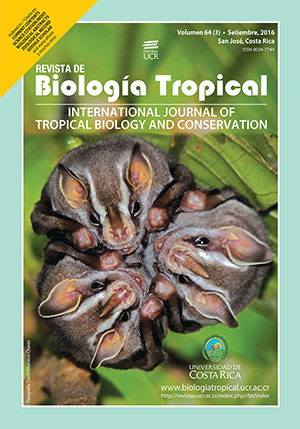Abstract
Treehoppers are known for their substrate-borne communication and some of them also for their subsocial behavior. Following a more general study of the natural history and substrate-borne signal repertoire of the treehopper Ennya chrysura, the objective of this paper was to explore in greater depth the signals and other behaviors associated specifically to egg-guarding. Theese were studied both in natural and laboratory conditions between July, 2000 and March, 2004. The spacial distribution of egg guarding females was studied in the natural population; recording equipment and playback experiments were used in the laboratory and then analyzed digitally. Under natural conditions (San Antonio de Escazú, Costa Rica), female E. chrysura guard their egg masses and egg-guarding was associated with lower parasitism of the eggs from the wasps Gonatocerus anomocerus and Schizophragma sp. (Mymaridae). Females tended to place their eggs close to other egg-guarding females and they produced substrate-borne vibrations when disturbed. An aggregated pattern under natural conditions was confirmed by calculating dispersion indices from egg-clutch data obtained from 66 leaves in the field. The disturbance signal was characterized from laboratory recordings of substrate-borne vibrations of 10 egg-guarding females. Experiments conducted in the laboratory with 18 egg-guarding females showed that those which were previously exposed to the disturbance signal of another female moved slightly or vibrated more during playbacks and that they reacted more quickly and exhibited more deffensive behaviors in response to a tactile stimulus. The signals produced while defending against egg parasites may therefore function as an alarm and favor aggregating behavior of egg-guarding females.
References
Avisoft Bioacoustics. (2002). Hardware and Software for Investigating Animal Acoustic Communication. Berlin: Avisoft-SASLab Pro Sound Analysis and Synthesis Software. Retrieved from http://www.avisoft.com/soundanalysis.htm
Blumstein, D. T., Evans, C. S., & Daniel, J. C. (2000). Jwatcher 0.9 An Introductory User´s Guide. Australia: Animal Behaviour Laboratory, Macquarie University.
Buchler, E. R., Wright, T. B., & Brown, E. D. (1981). On the functions of stridulation by the passalid beetle Odontotaenius disjunctus (Coleoptera: Passalidae). Animal Behaviour, 29, 483-486.
Camacho, L., Keil, C., & Dangles, O. (2014). Factors influencing egg parasitism in sub-social insects: insights from the treehopper Alchisme grossa (Hemiptera, Auchenorrhyncha, Membracidae). Ecological Entomology, 39, 58-65.
Claridge, M. F. (1985). Acoustic signals in the Homoptera: behavior, taxonomy, and evolution. Annual Review of Entomology, 30, 297-317.
Cocroft, R. B. (2003). The social environment of an aggregating, ant-attended treehopper (Hemiptera: Membracidae: Vanduzea arquata). Journal of Insect Behavior, 16, 79-95.
Cocroft, R. B., & Rodríguez, R. L. (2005). The behavioral ecology of insect vibrational communication. Bioscience, 55, 323-334.
Cocroft, R. B., & McNett, G. D. (2006). Vibratory Communication in Treehoppers (Hemiptera: Membracidae). In S. Drosopoulos & M. F. Claridge (Eds.), Insect Sounds and Communication: Physiology, Behaviour, Ecology and Evolution (pp. 305-317). London: CRC Press.
Cocroft, R. B., & Hamel, J. A. (2010). Vibrational communication in the “other insect societies”: A diversity of ecology, signals, and signal functions. In C. O’Connel-Rodwell (Ed.), The use of vibrations in communication: properties, mechanisms and function across taxa (pp. 7-41). India: Research Signpost.
Cocroft, R. B., Rodríguez, R. L., & Hunt, R. E. (2010). Host shifts and signal divergence: mating signals covary with host use in a complex of specilized plant-feeding insects. Biological Journal of the Linnean Society, 99, 60-72.
Cocroft, R. B., Hamel, J. A., Su, Q., & Gimson, J. (2014). Vibrational Playback Experiments: Challenges and Solutions. In R. B. Cocroft, M. Gogala, P. S. M. Hill, & A. Wessel (Eds.), Studying Vibrational Communication (pp. 248-274). Berlin: Springer-Verlag.
Eberhard, W. G. (1986). Possible mutualism between females of the subsocial membracid Polyglypta dispar (Homoptera). Behavioral Ecology and Sociobiology, 19, 447-453.
Godoy, C., Miranda, X., & Nishida, K. (2006). Treehoppers of tropical America. Costa Rica: National Institute of Biodiversity.
Klump, G. M., & Shalter, M. D. (1984). Acoustic behavior of birds and mammals in the predator context: I. Factors affecting the structure of alarm signals, II. The functional significance and evolution of alarm signals. Zeitschrift fur Tierpsychologie, 66, 189-226.
Krebs, C. J. (1999). Ecological Methodology. California: Addison-Wesley Educational Publishers Inc.
Lin, C. P. (2006). Social behaviour and life history of membracine treehoppers. Journal of Natural History, 40, 1887-1907.
Marshall, D. C. (2000). Behavior and evolution of periodical cicadas (Magicicada spp.) (Ph.D. dissertation). University of Michigan, Michigan, USA.
Masters, W. M. (1979). Insect disturbance stridulation: its defensive role. Behavioral Ecology and Sociobiology, 5, 187-200.
Miranda, X. (2006). Substrate-borne signal repertoire and courtship jamming by adults of Ennya chrysura (Hemiptera: Membracidae). Annals of the Entomological Society of America, 99, 374-386.
Morales, M. A., Barone, J. L., & Henry, C. S. (2008). Acoustic alarm signalling facilitates predator protection of treehoppers by mutualist ant bodyguards. Proceedings of the Royal Society, 275, 1935-1941.
Stegmann, U. E., & Linsenmair, K. E. (2002). Subsocial and aggregating behaviour in Southeast Asian treehoppers (Homoptera: Membracidae: Centrotinae). European Journal of Entomology, 99, 29-34.
Syntrillium Software Corporation. (1999). Cool Edit Pro Version 1.2 User Guide Addendum. Syntrillium Software Corporation. Retrieved from http://www.inventati.org/akusmatik/base/tutorials/manual/cep12add.pdf
Wong, J. W. Y., Meunier, J., & Kölliker, M. (2013). The evolution of parental care in insects: the roles of ecology, life history and the social environment. Ecological Entomology, 38, 123-137.
Wood, T. K. (1984). Life history patterns of tropical membracids (Homoptera: Membracidae). Sociobiology, 8, 299-344.
Wood, T. K. (1993). Diversity in the New World Membracidae. Annual Review of Entomology, 38, 409-35.
Zar, J. H. (1996). Biostatistical Analysis (3rd ed). New Jersey: Prentice-Hall.
##plugins.facebook.comentarios##

This work is licensed under a Creative Commons Attribution 4.0 International License.
Copyright (c) 2016 Revista de Biología Tropical






